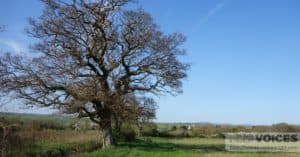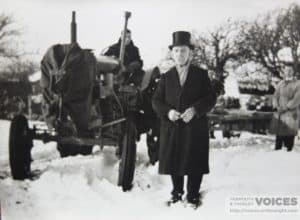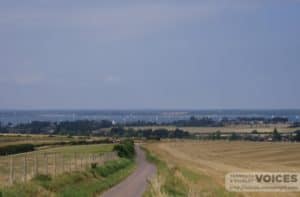Newclose Farm
How did I come to be milking the herd of cows at Newclose Farm?

Broad Lane to Newclose Farm buildings 2013 Newclose Farmhouse on left, old milking parlour at end of road.
I’d spent a couple of years at a rather grand school in London, Mary Datchelors, which was famous for its singing. It’s left me with a love for classical music, but I was such a dunce! After a couple of years in the Remove, struggling with algebra, geometry, trigonometry, Latin and French, they thought I’d better not go on.
So I came home, didn’t know what to do. ‘You’re too stupid to work in Woolworth’s,’ they told me, so they let me go to work farming.
I did three years at Cliff End at 2/6 a week. There was no keep included, but they bought cakes once a week on a Tuesday. The mice pretty soon got’em so they gave us the mousey ones, and we’d break off the mousey bits.
Do you know that little green magazine ‘The Countryman’? There was an advert in there from the UK Sponsoring Authority. You could go to a farm in France, Belgium or Holland. Well, I went off to Friesland in Holland. At Cliff farm they thought I was going off to darkest Africa – wouldn’t let me take my hoe and my 2 pronged fork that I’d saved up for and bought myself.
After a year in Holland, some time in Derbyshire and then in Devon, Ernest Heal offered me a job in charge of 30 cows at Newclose. Can you imagine how I felt? It gave me such confidence. He left me in charge, didn’t want to know unless there was anything wrong. I was so grateful to him. He opened so much for me in life.
Newclose Farm is on the crossroads and I used to have to take the heifers up Broad Lane to Dog Kennel. What a job! They’d run like mad and there were no hedges, they’d been taken out just before I started at Newclose.
I was smarter with the calves though. I had 6 or so and I bought some halters and used to walk them up through the fields by where Holmfield Avenue is – there was just the one house there. Mind you, I’d be walking them over the crossroads and a bus would come, and the calves would be tying themselves up.

Picking up sheaves with working horses
Char Courtney and Shep Hillier worked there too. Char was in charge of the tractor and the horse – Ernest Heal had the last working horse on the Island. Char was supposed to know the names of all the cows and all about them; which ones needed a stone on the machine when they were being milked and so on. Did he hell! He knew all the horses at the bookies!
One day he was driving the tractor, getting the kale from a field up Broad Lane. The tractor couldn’t get up the slope but the old horse could.
I worked there for about 3 or 4 years till 1956. I didn’t live there, I had a room at The Old House in Yarmouth with a Mrs Weston – £7 a week it cost me, the same as I earned, so Ernest Heal had to make my money up a bit, because I smoked too in those days. In the summer I lived in a sort of shed at the end of Wheatsheaf Lane.
Den ( Dennis Phillips from Compton farm)) and I were courting, while I was at Newclose. I remember sitting in a ditch at the side of the farm chatting with the old roadmen. One of them had a wooden leg so I used to help him chuck up the sweepings into the cart. A lorry went by, ‘Oh look, it’s a Dennis!’ I said and didn’t they tease me!
We did have our own names for places. We called the cross roads ‘Flat Rat cross roads’…
When I left to get married, Ernest Heal gave me several bits of silver plate which must have been in his family. One is a real beauty, a simple epergne, which looks lovely with fruit piled up.
Jane Phillips nee Alder b 1932









